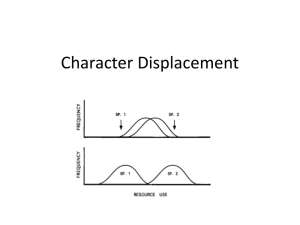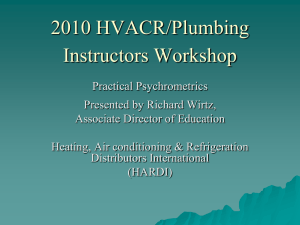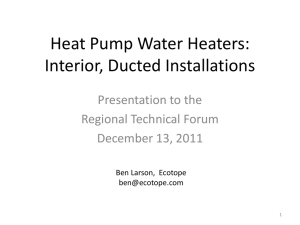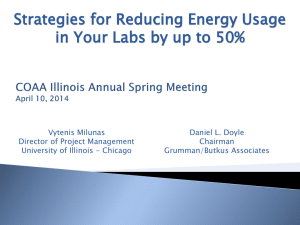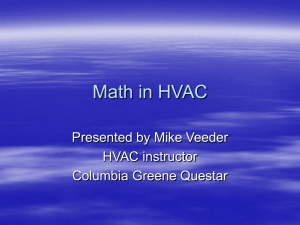Displacement for Classrooms
advertisement
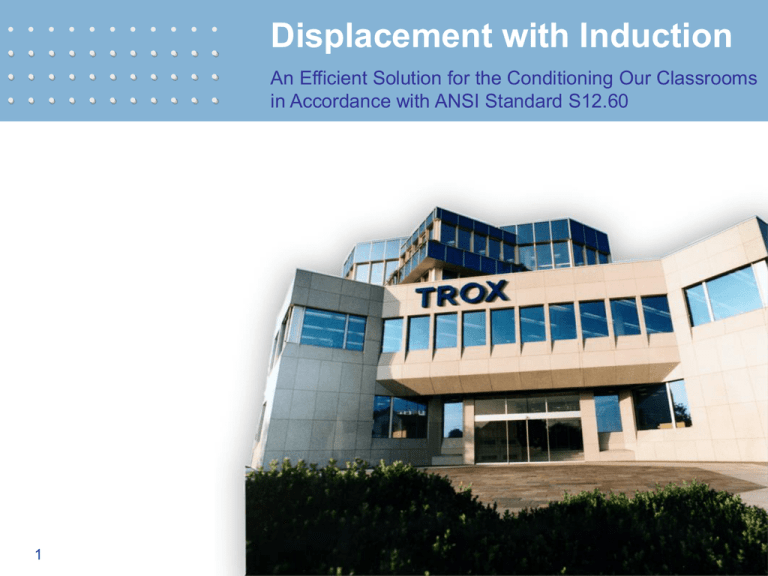
• • • • • • • • • • • • 1 • • • • • • • • • • • • • • • • • • • • • • • • • • • • • • • • Displacement with Induction An Efficient Solution for the Conditioning Our Classrooms in Accordance with ANSI Standard S12.60 • • • • • • • • • • • • • • • • • • • • • • • • • • • • • • • • • • • • • • • • • • • • Classroom Design Issues • Classroom minimum ventilation rates – ASHRAE Standard 62 – 15 CFM per student 2 • • • • • • • • • • • • • • • • • • • • • • • • • • • • • • • • • • • • • • • • • • • • • Minimum ventilation rates Classroom Design Issues • Guidelines for thermal comfort – ASHRAE Standard 55 – Summer design: – Winter design: 3 75 to 78º F DB (WB not to exceed 64º F) 70 to 72º F DB • • • • • • • • • • • • • • • • • • • • • • • • • • • • • • • • • • • • • • • • • • • • • • Ventilation rates Thermal comfort Classroom Design Issues • Classroom acoustical standards – ANSI Standard S12.60 – 35 dBA (NC27) in core learning areas 4 • • • • • • • • • • • • • • • • • • • • • • • • • • • • • • • • • • • • • • • • • • • • • • • Ventilation rates Thermal comfort guidelines Classroom acoustical standards Classroom Design Issues • Reliability and maintenance requirements – Routine maintenance can be performed by school personnel – Simple to operate and maintain 5 • • • • • • • • • • • • • • • • • • • • • • • • • • • • • • • • • • • • • • • • • • • • All Air Solutions for Classroom HVAC • Constant air volume, variable temperature solutions – Water source heat pumps – Unit ventilators – Fan coil units – Series type fan powered terminals 6 • • • • • • • • • • • • • • • • • • • • • • • • • • • • • • • • • • • • • • • • • • • • All Air Solutions for Classroom HVAC • Constant air volume, variable temperature solutions 7 – Ventilation airflow guaranteed as airflow rate is constant – Airflow to handle sensible load 2 to 2.5 times ventilation rate – Airflow delivery maintained at all times – Difficult to achieve acceptable classroom noise levels • • • • • • • • • • • • • • • • • • • • • • • • • • • • • • • • • • • • • • • • • • • • • All Air Solutions for Classroom HVAC Constant air volume, variable temperature solutions • Variable air volume solutions – Single duct VAV with reheat – Variable speed fan terminals with reheat – Parallel type fan powered terminals 8 • • • • • • • • • • • • • • • • • • • • • • • • • • • • • • • • • • • • • • • • • • • • • All Air Solutions for Classroom HVAC Constant volume, variable temperature solutions • Variable air volume solutions 9 – Airflow delivery is proportional to conditioning requirements – Ventilation rate is compromised as airflow rate is reduced – Space humidity ratios vary with delivered airflow rate • • • • • • • • • • • • • • • • • • • • • • • • • • • • • • • • • • • • • • • • • • • • Displacement Conditioning of Classrooms TSHG = 25 BTUH/FT2 = 22,500 BTUH Minimum Ventilation = 26 x 15 = 405 CFM 2 Displacement Diffusers @ 600 CFM/ea. 22,500 BTUH 10 • • • • • • • • • • • • • • • • • • • • • • • • • • • • • • • • • • • • • • • • • • • • Displacement Conditioning of Classrooms Heat Source 11 12 • • • • • • • • • • • • • • • • • • • • • • • • • • • • • • • • • • • • • • • • Displacement Conditioning of Classrooms TRETURN = 80º F DTSR = 18º F Elevation • • • • 75ºF Occupied Zone 70ºF TSUPPLY = 62º F Local Temperature Increase 13 • • • • • • • • • • • • • • • • • • • • • • • • • • • • • • • • • • • • • • • • • • • • Displacement Conditioning Advantages • High CO2 removal efficiencies • Excellent space acoustics • Reduced operational costs in mild climates – Extended economizer opportunities – Possible chiller operational efficiency enhancements 14 • • • • • • • • • • • • • • • • • • • • • • • • • • • • • • • • • • • • • • • • • • • • Displacement Conditioning Issues • Slightly higher airflow rates – Typically 15 to 20% higher than conventional systems – Results in larger ductwork, terminal units and fans 15 • • • • • • • • • • • • • • • • • • • • • • • • • • • • • • • • • • • • • • • • • • • • • Displacement Conditioning Issues Slightly higher airflow rates • Separate heating system required – Warm air discharged by terminals rises immediately – Heating by separate source to maintain displacement 16 • • • • • • • • • • • • • • • • • • • • • • • • • • • • • • • • • • • • • • • • • • • • • • Displacement Conditioning Issues Slightly higher airflow rates Separate heating system required • Dehumidification issues in much of North America – Outdoor air must be cooled to saturation, then reheated – Complicates air handling unit design and control 17 • • • • • • • • • • • • 18 • • • • • • • • • • • • • • • • • • • • • • • • • • • • • • • • Displacement System Air Handling Unit Design Exhaust Air Return Air 450 CFM @ 84F 1350 CFM @ 83F Outside Air Supply Air 450 CFM @ 94F 1350 CFM @ 64F • • • • • • • • • • • • • • • • • • • • • • • • • • • • • • • • • • • • • • • • • • • • Displacement with Induction • Induction Nozzles – Primary air delivered at 50 to 55ºF – Mixing within terminal elevates supply air to appropriate temperature • Integral Heat Transfer Coil – Room air induced through coil – Supplements space cooling – Eliminates separate heating system 19 • • • • • • • • • • • • • • • • • • • • • • • • • • • • • • • • • • • • • • • • • • • • Displacement with Induction Cooling mode operation Return Air 450 CFM (82 to 85ºF) Primary Airflow 450 CFM (50 to 54ºF) Room Air 900 CFM (75 to 78ºF) Chilled Water Supply Airflow 1350 CFM (61 to 68ºF) 20 100% Exhausted • • • • • • • • • • • • • • • • • • • • • • • • • • • • • • • • • • • • • • • • • • • • Displacement with Induction Heating mode operation 100% Exhausted Return Air Optional Heat 450 CFM Recovery Primary Airflow 450 CFM (50 to 60ºF) Room Air 900 CFM (70 to 72ºF) Hot Water Supply Airflow 1350 CFM (82 to 85ºF) 21 • • • • • • • • • • • • • • • • • • • • • • • • • • • • • • • • • • • • • • • • • • • • Displacement with Induction Staggered heating operation Cooling Only Heat and Cool Cooling Only 22 • • • • • • • • • • • • 23 • • • • • • • • • • • • • • • • • • • • • • • • • • • • • • • • QLCI Installation Step 1: Install retaining studs • • • • • • • • • • • • 24 • • • • • • • • • • • • • • • • • • • • • • • • • • • • • • • • QLCI Installation Step 2: Install water piping • • • • • • • • • • • • 25 • • • • • • • • • • • • • • • • • • • • • • • • • • • • • • • • QLCI Installation Step 3: Mount and connect QLCI terminals • • • • • • • • • • • • 26 • • • • • • • • • • • • • • • • • • • • • • • • • • • • • • • • QLCI Installation Step 3: Mount and connect QLCI terminals • • • • • • • • • • • • 27 • • • • • • • • • • • • • • • • • • • • • • • • • • • • • • • • QLCI Installation Step 4: Install and connect air ducts • • • • • • • • • • • • 28 • • • • • • • • • • • • • • • • • • • • • • • • • • • • • • • • QLCI Installation Step 5: Replace front panels • • • • • • • • • • • • • • • • • • • • • • • • • • • • • • • • • • • • • • • • • • • • Advantages of Using Displacement with Induction • Classroom acoustics comply with ANSI S12.60 • Improved classroom IAQ – Minimum ventilation rate guaranteed – Displacement ventilation of classroom • Reduced operation and maintenance costs – Enhanced cooling efficiencies using chilled water versus air – Considerably lower air transport costs – Simple controls, few moving parts 29 • • • • • • • • • • • • • • • • • • • • • • • • • • • • Sensible Cooling Latent Cooling Fan/Duct Sizing Acoustics 30 • • • • • • • • • • • • • • • • Classroom Cooling Operational Summary Conventional Mixed System Conventional Displacement Displacement with Induction Primary Air: Recirculation: Bypass: 100% 0% 0% 70% 0% 30% 55% 35% 15% Primary Air: 100% 100% 65 to100% 0% 0% 0 to 35% Recirculation: CFM/FT2: NC: 1.2 1.5 0.5 35 to 45 < 25 25 to 30 • • • • • • • • • • • • • • • • • • • • • • • • • • • • • • • • • • • • • • • • Classroom Cooling Operational Costs Fan Energy (kWH) Annual Energy Use (kWH) • • • • Refrigeration (kWH) Pumping Energy (kWH) 6000 5000 33% Savings vs. WSHP! 4000 25% Savings vs. Unit Ventilators! 3000 2000 35% Savings vs. VAV System! 1000 0 QLCI VAV WSHP HVAC System Type 31 Unit Vent • • • • • • • • • • • • • • • • • • • • • • • • • • • • • • • • • • • • • • • • • • • • Advantages of Using Displacement with Induction • Classroom acoustics comply with ANSI S12.60 • Improved classroom IAQ • Reduced operational and maintenance costs • Simplified air handling unit design and operation – Air handling unit size reduced considerably – Recirculation at air handler is minimal or eliminated altogether 32 • • • • • • • • • • • • • • • • • • • • • • • • • • • • • • • • • • • • • • • • • • • • Displacement with Induction Air Handling Unit Design Optional Heat Recovery Exhaust Air Return Air 450 CFM @ 84F 450 CFM @ 83F Outside Air Room Air Induction 450 CFM @ 94F Primary Air 450 CFM @ 51F 33 • • • • • • • • • • • • 34 • • • • • • • • • • • • • • • • • • • • • • • • • • • • • • • • Displacement with Induction An Efficient Solution for the Conditioning Our Classrooms in Accordance with ANSI Standard S12.60

